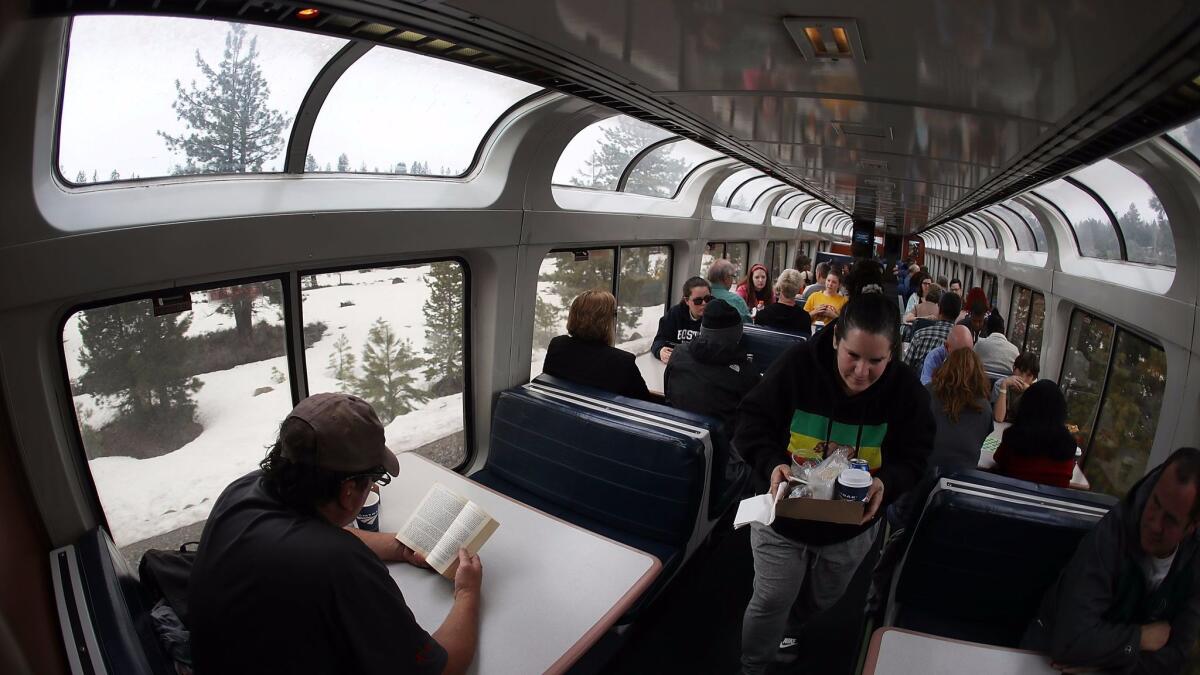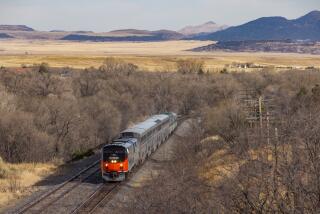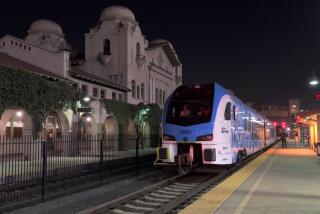As it travels through the mountains and plains of the West, the California Zephyr is a track star

I love the West, its granite peaks, endless grasslands and twisting canyons, which sounds like the ultimate car trip. Wrong. I think these sights are best viewed by rail, not road.
That’s why I decided to ride Amtrak’s California Zephyr from Denver to San Francisco. At several points along a route that carried me 1,260 miles, the rails deviate far from ribbons of pavement, taking off across lands you would never see from the highway.
I looped much of the West by rail on this May journey. After the Zephyr, I also rode the Coast Starlight from San Francisco to Los Angeles and the Sunset Limited from Los Angeles to San Antonio.
Once there, I picked up the Texas Eagle to Fort Worth and the Heartland Flyer for my return to Oklahoma City.
I saw the deserts of the Southwest, cities such as El Paso, Texas, and much of California, and I came to understand each region better.
But the Zephyr, which originates in Chicago and traverses Colorado, Utah and Nevada, cutting over to Sacramento and ultimately arriving in the Bay Area, pleased me most.
Without the pressure of having to pay attention to the road, I could watch the scenery unfold, a luxury in our all-things-in-a-hurry world.
Unfortunately, the sun must set
Amtrak offers four routes across the West; the Empire Builder, from Chicago to Seattle, the Southwest Chief from Chicago to Los Angeles, the Sunset Limited from New Orleans to Los Angeles; and the Zephyr.
I chose a two-day Zephyr journey because it included Glenwood Springs, Colo., one of my favorite mountain towns, and because it crossed the Rockies, the Wasatch mountains and the Sierra, holding out the promise of spectacular scenery.
Even with research, there are things you won’t know about your train trip unless you venture beyond the Amtrak website.
For instance, certain sections of the trip, of necessity, happen at night. The Empire Builder, a train that also originates in Chicago and flirts a bit with the Canadian border on its western journey, crosses the northern Rockies and most of Montana’s Glacier National Park in the dark.
The California Zephyr passes through Salt Lake City, along the Great Salt Lake and through northern Nevada, also under the cloak of darkness.
These important nuggets of information can be found on the web at www.lat.ms/moretraininfo
Because Amtrak does not own the rails it uses, it’s required to pull over for commercial freight trains. This means it is frequently off schedule and often runs late, an unwelcome surprise.
And off we go
The Zephyr left Denver’s Union Station at 8 a.m., which should have placed us at midday in the middle of Glenwood Canyon.
That would give me most of the day to enjoy neighboring Glenwood Springs, a mountain town of 10,000 about 180 miles west of Denver along the western slope of the Rockies.
I chose coach for every leg of my journey, partly because it’s far less expensive than a sleeping compartment. Coach cars are at the rear of the train, and a snack bar is downstairs in the observation car, which is open to all passengers.
The dining car on the upper level called people for breakfast soon after we left Denver’s Union Station. But I passed on the morning meal so I could sit in the observation car, where I watched the city fade away as the train corkscrewed up and into the Rockies.
We passed mountain meadows and were treated to alpine vistas. Laughter broke out past Granby, Colo., when we passed a fence made of discarded skis.
One of the journey’s highlights was seeing 12-mile-long Glenwood Canyon with its curving spires of granite and its castle-like walls bisected by the Colorado River. The views are so spectacular that Amtrak claims it developed its observation cars for the Zephyr so travelers could view the canyon as the train slowly snakes through it.
We arrived in Glenwood Springs about noon, having made up for a 20-minute delay when we ceded the tracks to a freight train.
The red sandstone depot in Glenwood awaited. I stopped here for a day to see some sights and to get a good night’s sleep. There are plenty of nice accommodations — the 1893 Hotel Colorado (www.hotelcolorado.com, doubles from $149 a night) or the Hotel Denver (www.thehoteldenver.com, doubles from $139).
I chose the Starlight Lodge (www.starlight-lodge.com), for which I paid $65 for the night for a clean, comfortable basic room.
As a history buff, I took the two-mile walk that afternoon that travels uphill from the depot to the grave of Doc Holliday, the famed Old West gunfighter whose participation in the Gunfight at OK Corral in Tombstone, Arizona Territory, is the stuff of legend.
The walk is a 10% grade, steep enough to confirm whether you need to exercise more. I apparently do.
To restore myself, for dinner I had a steak accompanied by a fine stout at the Glenwood Canyon Brewing Co. inside the Hotel Denver.
I also ate well the next morning at the 19th Street Diner, then loaded up on as many snacks as I could squeeze into my carry-on to defray my costs in the dining car, where entrées started at $18.
I wasn’t the only snacker in coach, where meals aren’t included (unlike the sleeper car riders, where they are). One family sliced and shared watermelons; a man across from me unzipped a bag revealing a case of beer.
But I also think that part of any journey, especially on a train, is meeting fellow travelers, so I went to the dining car early and ordered the least expensive menu item, sharing a table with a retired Australian couple who were experiencing the U.S. by rail.
It was still light when we pulled into Grand Junction, Colo., after dinner, 87 miles from Glenwood Springs. The conductor told us the train depot had a store with coffee and snacks but advised us to use our time wisely because we had only 15 minutes.
The Australian woman shouted to her husband to bring back some Italian coffee. The store was all but barren, its walls bear and its shelves half-empty. The woman’s husband picked up a coffee pot that had been sitting on a burner for too long. He sniffed it and the expression on his face plainly said, “No coffee, Italian or otherwise, for you, my dear.”
Thirty minutes past Grand Junction, a group of whitewater rafters, setting up camp on the riverbank, in unison dropped their pants while turning their backs on the train, explaining why this stretch of the Colorado River is called Moon River.
As the land transformed from mountains to the dramatic red cliffs of plateaus, we entered Utah. Pronghorn antelope appeared now and then along the horizon line.
Near the peak of Soldier Summit in the Wasatch Mountains, I watched a beaver repairing its dam.
This may be the land of western movies, but it’s also the land of modern art. I was surprised when the train passed a 44-foot-tall tower titled “Ratio” near Green River, Utah. “Ratio” was made of white concrete blocks; one was missing from the second row from the bottom, and a solitary black block was placed in the second row from the top.
The $145,000 art piece was created by Australian Andrew Rogers, who selected Green River because of its emptiness.
But life on the train was full and rich, sometimes not in a good way. Somewhere in northern Nevada, the conductor caught an intoxicated passenger smoking in the restroom. Smoking is strictly prohibited on the train and is allowed only outside during our stops.
When the passenger cursed at the conductor, the train pulled onto a siding, and the man was handed over to law enforcement, which put us 90 minutes behind schedule.
We stopped in Reno in the morning, and two California state museum interpreters boarded; their presentation in the observation car focused on the Donner party, pioneers trapped in the snowy Sierra during the winter of 1846-47.
Help didn’t arrive for four months, and by then, the starving travelers turned to cannibalism to survive.
We could see the remnants of heavy winter snow as we sped through the Sierra Nevada trying to make up for lost time.
End of the route
We pulled into Emeryville, Calif., at 5 p.m., an hour late and in the grip of rush hour. Although there are plenty of hotels around the station, I had a reservation in San Francisco.
The conductor suggested I buy a Thruway bus ticket to downtown but told me I needed to hurry because it was leaving soon. (Ordinarily, you buy your ticket for this service when you make your train reservation, but the conductor hoped the ticket counter might help me get on that bus.)
It was a vain hope. The computers were down, but the clerk suggested I go to the bus stop across the street. There, the Emery Go-Round, a free shuttle, drops passengers at the MacArthur BART station.
My trip to downtown cost less than $4, and I exited within two blocks of my hotel.
My schedule didn’t allow much time for exploring. I had to rise early to return to Emeryville and catch the first part of my loop back to Oklahoma, a downside but offset by the positives of the Zephyr, truly a track star.
IF YOU GO
Zephyr tickets: A one-way saver coach seat from Denver to Emeryville can be as low as $114, depending on the time of year and the day of the week. The tab for a sleeper can be as low as $370, but again, varies by time of year and day.
Zephyr meals: Be prepared to pay $13 to $25 for a breakfast and anywhere from $17 to $24 for dinner in the diner. Coffee in the diner car and the snack room costs about $2. Packaged sandwiches in the snack bar cost about $7. Prices vary during season and from train to train.
If you or a traveling companion is disabled, you can specify this when you buy your ticket and you will be given a spot in one of the lower compartments, either in coach or in the sleeper car. You can read more about this at lat.ms/reservations.
Trains do not have elevators, only spiral narrow stairways, which means the dining car is off limits to those who use wheelchairs. The food is brought to the traveler.
Amtrak maintains a fleet of buses called Thruway for passengers to help them reach their final destination. For example, the Zephyr going west terminates in Emeryville, Calif., just across the bay from San Francisco. From there, Thruway will take you into San Francisco. You must buy your ticket for bus service when you buy your Amtrak fare.
For more information contact amtrak.com
More to Read
Sign up for The Wild
We’ll help you find the best places to hike, bike and run, as well as the perfect silent spots for meditation and yoga.
You may occasionally receive promotional content from the Los Angeles Times.






